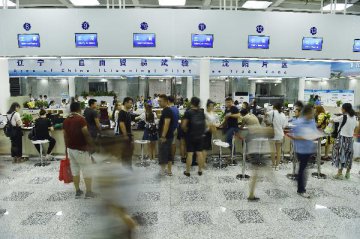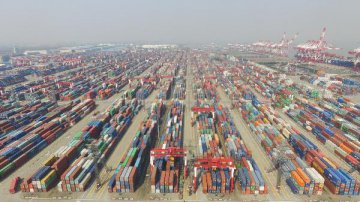
Since the official launch of seven pilot trade zones in Liaoning, Zhejiang, Henan, Hubei, Chongqing, Sichuan and Shaanxi on April 1, 2017, China's third batch of pilot trade zones have yielded fruitful results:
Liaoning speeded up restructuring northeast China's old industrial base, setting up special fund in support of key industries. From the date of inauguration till late 2017, 5,456 enterprises registered at Dalian Area of China (Liaoning) Pilot Free Trade Zone (FTZ), with a total registered capital of nearly 69.7 billion yuan, including 5,366 domestic-funded enterprises with registered capital of more than 66.3 billion yuan and 90 foreign-funded enterprises with registered capital of more than 500 million U.S. dollars.
Zhejiang established and improved the administrative system of bonded oil for ships engaged in international voyage while exploring innovation of regulation measures. From January to October 2017, 3,303 enterprises registered in the area utilizing a total inward investment of some 26.5 billion yuan. 639 oil enterprises registered in the zone with a total registered capital of 66.79 billion yuan.
Henan pushed forward building a multi-dimensional transportation system and modern logistics system eyeing for an international multimodal transport logistics centre. From April till late 2017, 23,623 enterprises set foot in the area, with a total registered capital of 317.54 billion yuan, including 139 foreign-funded enterprises. These enterprises have boosted Henan's foreign investment utilization, imports & exports and financial & tax revenues.
Hubei has been building a demonstration zone for receiving transferred industries in central China. In 2017, 8,105 enterprises were established in the area, including 8,048 domestic-funded enterprises with a total registered capital of 73.1 billion yuan and 57 foreign-funded enterprises.
Chongqing focused on building itself into a connectivity hub for the Belt and Road and the Yangtze River Economic Belt, exploring and expanding China-Europe freight train functions, lines and freight types. In 2017, 11,695 enterprises were added in the area, including 220 foreign-funded enterprises; and the zone attracted 692 projects with a total contract amount of 300.75 billion yuan.
Sichuan inked cooperation agreements with coastal areas towards coordinated opening-up of inland and coastal areas in ways of industry transfer cooperation and benefit sharing in attracting investments. In 2017, 19,200 enterprises registered in Chengdu Area of China (Sichuan) Pilot FTZ with a total registered capital of 295 billion yuan, including 211 foreign-funded enterprises.
Shaanxi carried out whole-chain production and operation piloting, and established more than 2,000 chain bases with a total scale of more than 3 million mu outside China (Shaanxi) Pilot FTZ which supply food to more than 15 million people daily. As of late 2017, 9,347 enterprises (including 107 foreign-funded enterprises) had registered in the zone, with a total registered capital of 309.98 billion yuan (including a total foreign investment of 670 million U.S. dollars).
Connecting B&R construction
Notably, most of China's existing 11 pilot free trade zones, including those above, are responsible for connecting Belt and Road construction. For example, Shanghai FTZ, China's first pilot free trade zone incorporated into Belt and Road vision and action plan, shoulders the important function of infrastructural connectivity and financial agglomeration.
Similar to Shanghai, Zhejiang is at the junction of the "Yangtze River Economic Belt" and the "Maritime Silk Road". China (Zhejiang) Pilot FTZ focusing on the Port of Ningbo-Zhoushan will become a maritime gateway in China's new-round opening to the outside world.
China (Guangdong) Pilot FTZ has been building a logistics, investment and trade hub through economic and trade contacts with the countries and regions along the "21st Century Maritime Silk Road", to serve the construction of the "21st Century Maritime Silk Road".
As the core zone of the "21st Century Maritime Silk Road", China (Fujian) Pilot FTZ can exploit its historical and humanistic advantages as the starting point of the Ancient "Maritime Silk Road", to strengthen economic and trade connection with the countries along the road.
As one of the 18 major provinces and autonomous regions in the Belt and Road plan, Liaoning shoulders the mission of opening to China-Mongolia-Russia Economic Corridor and Northeast Asia.
As inland provinces, Henan and Shaanxi are also in pivotal positions of the "Silk Road Economic Belt".
According to statistics, currently the pilot FTZs contribute about 30 percent of China's total import and export trade volume. A FTZ network based on the surrounding areas, radiating the Belt and Road and targeting the world is taking shape in China.
Spillover effects
According to a media report, the third pilot free zones are preparing task lists of new-round reform, opening-up and innovation. For example, Zhejiang is exploring a bulk commodity cross-border trade account; and will greatly lower the threshold for foreign investment access to the oil product industry. Henan is exploring a cross-border two-way RMB capital pool. Experts noted that the experience of the pilot free trade zone will soon be duplicated and extended, and spillover effect will appear this year.
According to Bai Ming, Deputy Director of the International Market Research Department of the Chinese Academy of International Trade and Economic Cooperation, the development environment of the export-oriented economy has changed profoundly. As the international market is becoming increasingly small, local areas should act initiatively based on their advantages and actual conditions, and seek internalized new dividends in opening up. Since the exploration of pilot FTZs, a lot of extendable experience has formed, and duplicating and extending such experience will be an important task in the next period.
























Latest comments